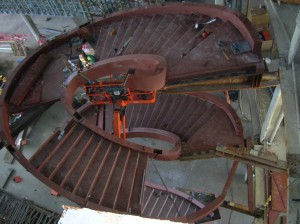Recently we rolled steel plate for a staircase inside the 5 Crescent Drive building in The Navy Yard located in Philadelphia. The 205,000 square-foot, four-story facility will be designed to achieve LEED Platinum certification, the highest possible designation in the internationally recognized sustainable building rating system. Due to the LEED Platinum status all material had to be domestic material. Meaning the steel had to be melted and manufactured in the USA. LEED project paperwork requires a letter from the producing mill showing the percentages of pre-consumer and post-consumer recycled content. All material had to be tagged with mark numbers and heat numbers so there is accountability and traceability when matching material with mill test reports.
The buildings new occupant will be GlaxoSmithKline, a leading worldwide research-based pharmaceutical company. Deirdre Connelly, president of GlaxoSmithKline and a Philadelphia resident said “This facility, with its environmentally friendly and efficient design, aligns with our global commitment to work smartly and operate as a green company”.
LEED, or Leadership in Energy and Environmental Design, is an internationally-recognized Green Building certification system. Developed by the U.S. Green Building Counsel (USBGC) in March 2000, LEED provides building owners and operators with a framework for identifying and implementing practical and measureable green building design, construction, operations and maintenance solutions. LEED promotes sustainable building and development practices through a suite of rating systems that recognize projects that implement strategies for better environmental and health performance.
LEED certification provides verification that the building was designed and built using strategies aimed at achieving high performance in five key areas: sustainable site development, water savings, energy efficiency, materials selection and indoor environmental quality.
LEED certified buildings have shown that their designs have:
- Lowered operating costs and increased asset value
- Reduced waste sent to landfills
- Conserved energy and water
- Made buildings healthier and safer for occupants
- Reduced harmful greenhouse gas emissions
- Helped projects qualify for tax rebates and zoning allowances
- Lowered a structure’s carbon footprint and saved energy








